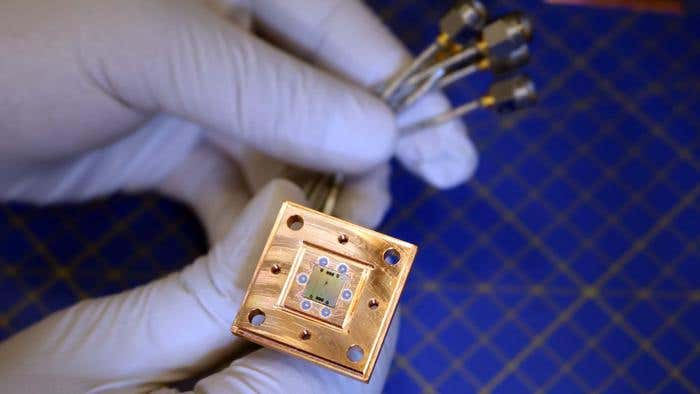Revolutionary quantum fridge slashes error rates in qubits
A new quantum fridge cools qubits to just 22 millikelvin, paving the way for fewer errors and more reliable quantum computing.

The new quantum refrigerator – the square object in the centre of the qubit in the image – is based on superconducting circuits and powered by heat from the environment. (CREDIT: Chalmers University of Technology | Lovisa Håkansson)
A new leap in quantum technology is changing how scientists keep qubits—quantum computing’s building blocks—ready for work. Researchers have created a tiny refrigerator that can cool qubits to lower temperatures than ever before. This breakthrough may solve one of the biggest challenges in quantum computing: starting with a clean, stable slate for every calculation.
This device is no ordinary fridge. It doesn’t plug into the wall or need software control. Instead, it powers itself with heat drawn from its surroundings and works entirely on its own. The result? A cooled qubit, free of errors, and better prepared for complex computing tasks.
Why Quantum Computers Need Special Care
Quantum computers don’t use regular bits like your phone or laptop. Instead, they use qubits. A bit can only be 0 or 1, but a qubit can be 0 and 1 at the same time. This trait, called superposition, helps quantum computers perform multiple calculations at once. It’s what makes them powerful tools for solving problems too hard for regular machines—like simulating molecules for new medicines or optimizing huge data sets in logistics.
But this power comes with a major problem: qubits are extremely fragile. A tiny spark of heat or the faintest radiation can throw off their values and cause errors. One early error can multiply, ruining the rest of the calculation. That’s why qubits must be cooled to nearly absolute zero—zero Kelvin or about minus 273.15 degrees Celsius. The colder they are, the less energy they have, which helps them stay stable.
Even the best quantum machines today use high-end dilution refrigerators to cool qubits to about 50 millikelvin. That’s 0.05 degrees above absolute zero. But getting colder than that has proven difficult—until now.
The Birth of the Quantum Refrigerator
A group of scientists from Sweden and the United States has found a new way to cool qubits even further. They built a quantum refrigerator using superconducting circuits—the same kind used in quantum computers. The device doesn’t need wires or power. It runs using a thermal gradient, or a natural temperature difference between warm and cold environments.
Related Stories
“The quantum refrigerator is based on superconducting circuits and is powered by heat from the environment,” said Aamir Ali, research specialist in quantum technology. “It can cool the target qubit to 22 millikelvin, without external control.”
That’s less than half the temperature of current systems. The lower the temperature, the better the reset. This reset means erasing the qubit, putting it back to its ground state—its lowest energy level—before doing new calculations. Ali added, “With this method, we were able to increase the qubit’s probability to be in the ground state before computation to 99.97 percent.”
Compared to the best earlier results of 99.8 to 99.92 percent, that small bump may seem minor. But in quantum computing, even tiny differences can matter. When millions of calculations run back to back, small improvements add up fast.
How the Quantum Refrigerator Works
This device does not use cold air or compressors. Instead, it uses three qubits. One is the “target” qubit that needs cooling. The other two are the heart of the cooling system. One of these helper qubits is connected to a warm “thermal bath”—a specially designed area full of microwave energy. The other helper qubit connects to a cold thermal bath.
Nicole Yunger Halpern, a physicist at the National Institute of Standards and Technology (NIST), explained it like this: “Energy from the thermal environment, channeled through one of the quantum refrigerator’s two qubits, pumps heat from the target qubit into the quantum refrigerator’s second qubit, which is cold.”
This process is continuous and automatic. Once it starts, it doesn’t need external feedback. The system stays stable and keeps doing its job—cooling the target qubit again and again as needed.
“Our work is arguably the first demonstration of an autonomous quantum thermal machine executing a practically useful task,” said Simone Gasparinetti, one of the lead researchers.
The entire device was built at the Myfab Laboratory at Chalmers University of Technology in Sweden. The team includes scientists from both Chalmers and the University of Maryland in the U.S.
A New Way to Erase the Chalkboard
The team compares a qubit to a chalkboard. Before solving a new problem, the board must be wiped clean. If any marks are left behind, they could be confused with new numbers. For qubits, that “cleaning” means removing extra energy.
“We think this approach will pave the way for more reliable quantum computing,” said Ali. “It’s hard to manage errors in quantum computers right now. Beginning closer to the ground state will compound into fewer errors you’d need to correct down the line.”
Until now, methods to reset qubits have been limited by temperature. Most methods could only cool them to about 40–49 millikelvin. Those results weren’t enough to fully remove early energy spikes that lead to calculation problems. The new system’s 22 millikelvin target offers a cleaner start—like using a brand-new chalkboard for every problem.
“If you didn’t cool the qubit to that low a temperature, you wouldn’t be able to erase the board as thoroughly,” said Yunger Halpern.
A Glimpse Into the Future
The team didn’t set out to change the future of quantum computing. Originally, this experiment was meant as a simple proof of concept. But the results exceeded expectations.
“It could address one of the problems in quantum computer design,” said Yunger Halpern. “It also shows that we can siphon heat from one part of the computer’s refrigerator and convert the heat into work.”
This approach might open the door to new tools and functions we haven’t yet imagined. With more fine-tuned cooling, quantum computers can run more reliable calculations and waste less time fixing early errors.
While quantum computers are still in development and not yet widely used, breakthroughs like this bring them closer to practical use. Researchers believe quantum machines could help design new drugs, improve encryption, and solve problems that are too complex for classical computers.
Backed by several major research foundations across Europe and the U.S., the team continues exploring how thermal energy and quantum circuits can work together.
Their paper, published in the journal Nature Physics, marks a key moment in the search for smarter, more stable quantum technology.
Note: The article above provided above by The Brighter Side of News.
Like these kind of feel good stories? Get The Brighter Side of News' newsletter.
Mac Oliveau
Science & Technology Writer | AI and Robotics Reporter
Mac Oliveau is a Los Angeles–based science and technology journalist for The Brighter Side of News, an online publication focused on uplifting, transformative stories from around the globe. Passionate about spotlighting groundbreaking discoveries and innovations, Mac covers a broad spectrum of topics—from medical breakthroughs and artificial intelligence to green tech and archeology. With a talent for making complex science clear and compelling, they connect readers to the advancements shaping a brighter, more hopeful future.



